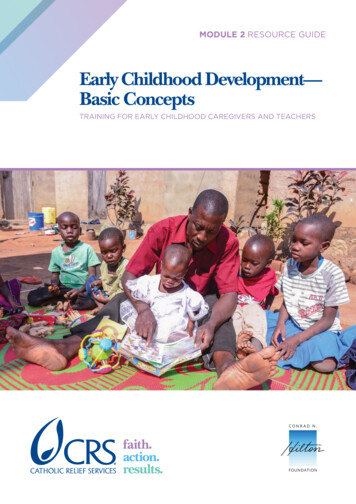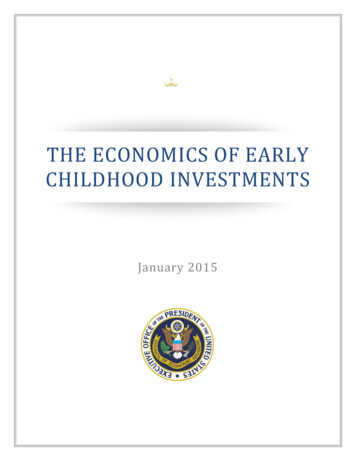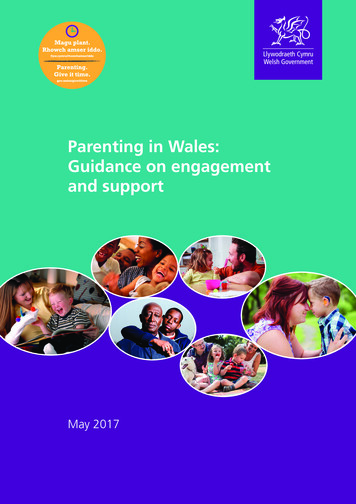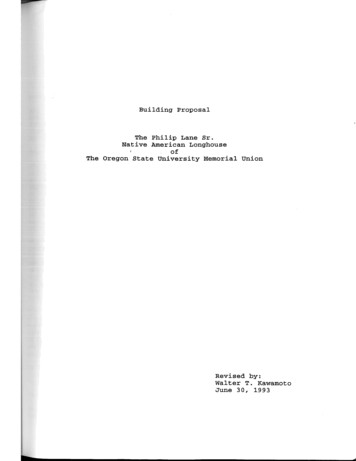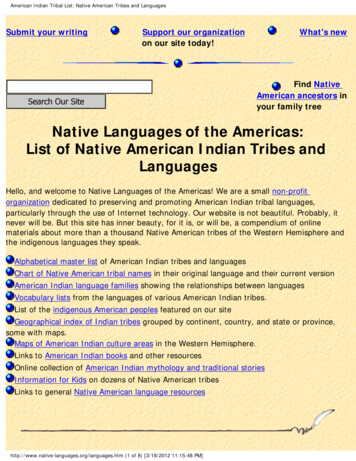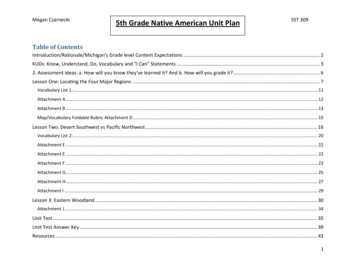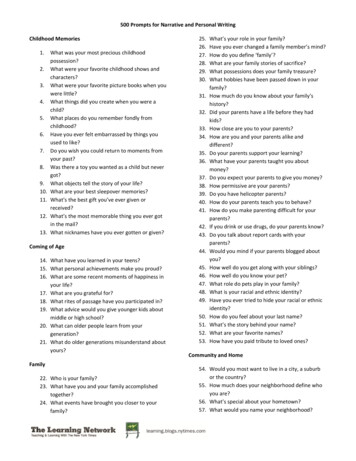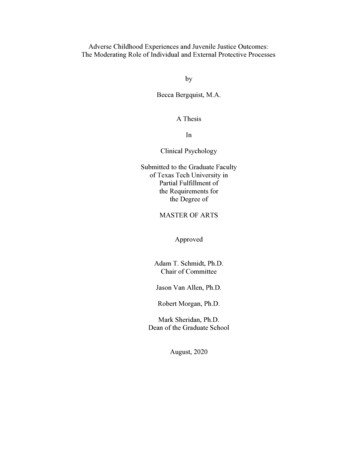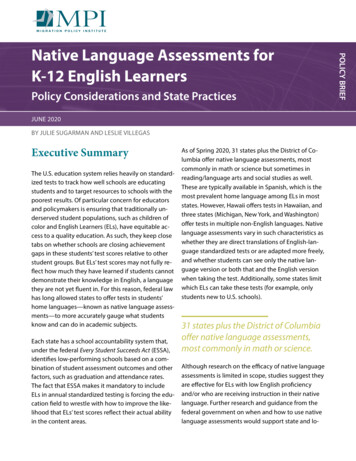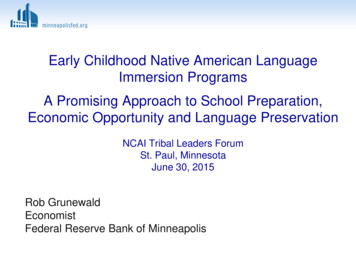
Transcription
Early Childhood Native American LanguageImmersion ProgramsA Promising Approach to School Preparation,Economic Opportunity and Language PreservationNCAI Tribal Leaders ForumSt. Paul, MinnesotaJune 30, 2015Rob GrunewaldEconomistFederal Reserve Bank of Minneapolis
SummaryResearch shows that high-quality early childhood educationhas a positive impact on children’s school performance andprovides the foundation for future workforce skills. Consistentwith this research, early childhood Native American languageimmersion programs have the potential to help childrenprepare for school and life as well as support efforts toincrease the number of Native language speakers. Whenimplemented with sufficient resources and high quality, earlylanguage immersion programs seem to support the goals ofschool preparation and future workforce skills as well asNative language preservation without downside risk to any ofthese outcomes.
On June 30, a paper with prepared remarks will beposted on the Federal Reserve Bank of MinneapolisEarly Childhood Development page. (Click Here)
minneapolisfed.orgLessons Learned from Research
Cleveland
The first few months and years of lifeare a sensitive period for braindevelopment and language acquisition.
Human Brain DevelopmentSynapse Formation Dependent on Early ExperiencesSensory Pathways(Vision, Hearing)LanguageHigher Cognitive FunctionFIRST YEAR-8 -7 -6 -5 -4 -3 -2 -1 1 2 3 4 5 6 7 8 9 10 11 1 2 3 4 5 6 7 8 9 10 11 12 13 14 15 16 17 18 19Birth(Months)(Years)Source: C. Nelson (2000), graphic by the Center on the Developing Child at Harvard University
Cumulative Vocabulary (Words)Barriers to Social Mobility Emergeat a Very Young Age1200College EducatedParents600WelfareParents20016 mos.24 mos.36 mos.Child’s Age (Months)Source: Hart & Risley (1995), graphic by the Center on the Developing Child at Harvard University
Risk Factors for Adult Heart Disease AreEmbedded in Adverse Childhood ExperiencesOdds Ratio3.532.521.510.501234ACEs5,67,8Source: Dong et al., (2004), graphic by the Center on the Developing Child at Harvard University
High-quality early learning programsproduce high public returns.
High/Scope Study of Perry Preschool In early 1960s, 123 children from low-incomefamilies in Ypsilanti, Mich. Children randomly selected to attend Perry orcontrol group. High-quality program with well-trained teachers,daily classroom sessions and weekly homevisits. Tracked participants and control group throughage 40.
Perry: Educational EffectsAge 14 achievementat 10th percentile Graduated from highschool on timeDidn't requirespecial education0%25%Program groupSource: Schweinhart et al. (2005)50%75%No-program group100%
Perry: Economic Effects at Age 40Own homeEarn 25,000 Have a savingsaccount0%25%50%Program groupSource: Schweinhart et al. (2005)75%100%No-program group
Perry: Arrested 5 or More Times Before Age 40Program groupNo-program group0%Source: Schweinhart et al. (2005)20%40%60%
Perry PreschoolCosts and Benefits Over 62 YearsProgram CostK-12 EdHigher Participants' EarningsJustice SystemCrime VictimsFor PublicSource: Schweinhart et al. (2005) 140,000 100,000 60,000 20,000- 20,000Welfare PaymentsFor Participant
Perry Preschool —Estimated Return on Investment Benefit-Cost Ratio 16 to 1 Annual Rate of Return 18% Public Rate of Return 16% Heckman Reanalysis 10%Sources: Schweinhart et al. (2005); author’s calculations; Heckman, Moon,Pinto, Savelyez, & Yavitz (2010)
Benefit-Cost Ratios forOther Longitudinal Studies Abecedarian Educational Child Care– 4 to 1 Chicago-Child Parent– 10 to 1 Elmira Prenatal/Early Infancy Project– 5 to 1Sources: Masse & Barnett (2002); Reynolds, Temple, White, Ou & Robertson (2011);Karoly et al. (1998)
Lessons Learned from Research Invest in quality Involve parents Start early Reach vulnerable children and families Bring to scale
Early Childhood Native American LanguageImmersion Programs Preschool or kindergarten classes connected with anelementary school or full K-12 program. “Language nest” programs for infants, toddlers andpreschoolers where Native language is spoken byadults and children.
Promise of Early Childhood Native AmericanLanguage Immersion Programs School preparation and success Economic opportunity through stronger workforce skills Native language preservation
SourcesDong, M., Giles, W., Felitti, V.J., Dube, S.R., Williams, J.E., Chapman, D.P., & Anda, R.F. (2004). “Insights into causalpathways for ischemic heart disease: Adverse Childhood Experiences Study.” Circulation 110, 1761–1766.Fortune, T.W. and Tedick, D.J. (2008). One-Way, Two-Way and Indigenous Immersion: A Call for Cross-Fertilization.Pathways to Multilingualism: Evolving Perspectives on Immersion Education, Ed. Fortune, T.W. and Tedick, D.J. TheCromwell Press Ltd.Hart, B., & Risley, T.R. (1995). Meaningful Differences in the Everyday Experience of Young American Children. Baltimore:Paul H. Brooks Publishing Co.Heckman, J. J., Moon, S.H., Pinto, R., Savelyez, P., & Yavitz, A. (2010). “The Rate of Return to the HighScope PerryPreschool Program.” Journal of Public Economics 94(1-2), 114-28.Karoly, L.A., Greenwood, P.W., Everingham, S.S., Hoube, J., Kilburn, M.R., Rydell et al. (1998). Investing in Our Children:What We Know and Don’t Know About the Costs and Benefits of Early Childhood Interventions. Santa Monica, Cal.: RANDCorporation.Masse, L.N., & Barnett, W.S. (2002). A Benefit-Cost Analysis of the Abecedarian Early Childhood Intervention. NewBrunswick, N.J.: National Institute for Early Education Research.
SourcesNelson, C.A. (2000). Neural Plasticity and Human Development: The Role of Early Experience in Sculpting Memory Systems.Developmental Science 3, 115-130.Pease-Pretty On Top, J. (2002). Bringing Thunder. Tribal College Journal of American Indian Higher Education. Vol 14, No.1.Reynolds, A.J., Temple, J.A., Robertson, D.L., & Mann, E.A. (2002). “Age 21 Cost-Benefit Analysis of the Title I Chicago ChildParent Centers.” Educational Evaluation and Policy Analysis 4(24), 267-303.Schweinhart, L.J., Montie, J., Xiang, Z., Barnett, W.S., Belfield, C.R., & Nores, M. (2005). Lifetime Effects: The High/ScopePerry Preschool Study Through Age 40. Ypsilanti, Mich.: High-Scope Press.Wilson, W.H. and Kamana, K. (2011). Insights from Indigenous Language Immersion in Hawai’i. Immersion Education:Practices, Policies, Possibilities, Ed. Tedick, D.J., Christian, D. and Fortune, W.F. Short Run Press Ltd.
High/Scope Study of Perry Preschool In early 1960s, 123 children from low-income families in Ypsilanti, Mich. Children randomly selected to attend Perry or control group. High-quality program with well-trained teachers, daily classroom sessions and weekly home visits.

